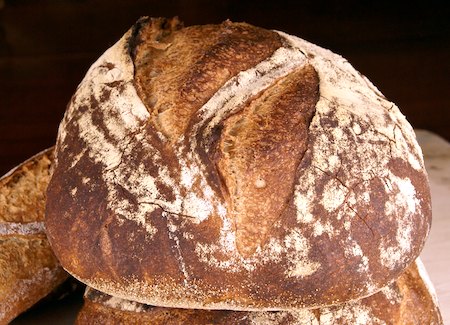 Teff Poolish Bread with a good crust
Teff Poolish Bread with a good crust
Call me shallow, but I do judge books by their covers, and breads by their crusts. For most of the hearth loaves I bake, I’m looking for a gorgeously brown, thin, crisp crust that “sings” when it comes out of the oven and shatters under the knife on the cutting board. I don’t always get it, but here are some things that help:
- Steam the oven, but not too much. Steam promotes a rich, lustrous crust color and good volume, but too much makes the crust chewy rather than crisp, and makes your loaves look like they’ve been dipped in shellac. Some ovens hold steam better than others, so experiment with steaming methods, how much water you need to use, and when to open the oven door to vent the steam, to determine what’s best for you.
- Don’t underbake. The baking times in recipes are guidelines. If your crust is too pale after the recommended baking time, bake it longer, to the darkness you like. It’s hard to overbake bread.
- Experiment with oven temperature. Again, the temperatures in recipes are guidelines. When I moved to my current home several months ago, I found that my results in my new oven are better with temperatures about 25 degrees above what I used in my old oven, even though my oven thermometer indicates that both ovens heat true to the set temperature. Go figure. I just know it works, so I do it. (That’s Baking Rule #1, by the way.)
- Don’t overferment the dough. If the dough ferments too long, the yeast will consume all the sugars that would otherwise contribute to crust color, and the crust will be pale.
- A small amount of diastatic malt in the dough helps promote crust color by increasing the conversion of starch into sugar.
- Skip the fat and sugar. These work to make the crust soft. Sometimes this is what you want (think pan-baked sandwich breads), but lean doughs work better for crusty hearth loaves.
- At the end of the bake, leave the loaves in the oven with the door ajar (propped open a bit with a wooden spoon). The drives off excess moisture.
- Don’t store your bread in plastic bags. This is the fastest route to softening your hard-won crust. Bread that will be eaten within a couple of days stays on my cutting board, cut side down, unwrapped. If I’m giving a loaf to someone, I put it in a paper bag. The rest goes in the freezer.
Notice that most of these suggestions rely on making adjustments according to your equipment, your environment, and your desired results. If you want a one-size-fits-all set of directions, bread baking is probably not the hobby for you, but I hear paint by number kits can be fun.
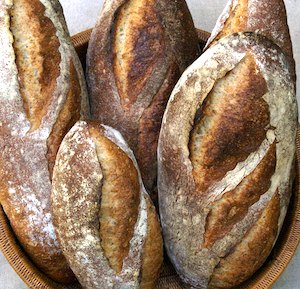
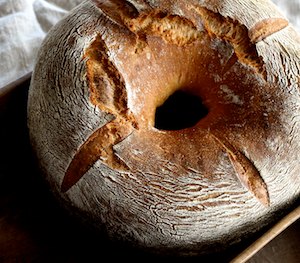
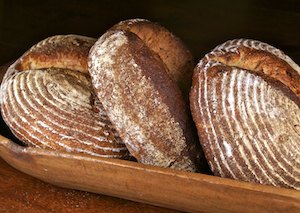
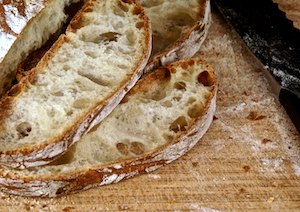
Beautiful loaves of bread with great looking crusts, Susan. Good advice too. Your pictures of your breads are always so delicious looking!
No one will ever go wrong following your advice! It’s beautiful stuff. One thing I like to do is to wrap the cooled loaves in linen towels and leave them cut side down on the cutting board. That preserves the crispness but gives them a little protection from the outside world.
Great looking loaves and great advice. Didn’t know that fat makes the crust go soft. Thanks!
I have been learning a lot from you and my breads became much better after that. I just love to bake, although I live in a very small and very warm town in Brazil, so I can`t find special flour, my oven is a domestic one, and I do not have a baking stone. I do my best and we eat home made bread that is a lot better than the ones we can bye. I can`t thank you enough. I love your site.
Thank you Susan. You always have great info to share.
Thanks Susan, for showing these good looking crusts and your advice. I had no idea it’s hard to overbake bread. My next loaves will have more color!
Beautiful! Makes me want to eat it.
Again, Susan thanks for the wonderful advise. I especially needed the one about not underbaking the bread. It must be that heavenly aroma coming from the kitchen, but I can hardly wait to take the bread out of the oven. Many times it just seems under baked, even though the temperature of the bread seems correct.
I am hoping to get back to SFBI again this year for another wonderful weekend of learning and hands on baking.
Crust definitely makes the bread.
From personal experience the best(and easiest) way to make an amazing crust is to use a Cloche bread baker. I tried many different techniques and had some successes and then I got one and never looked back.
Other than the always nerve racking experience of taking the 500 degree lid off of one inside the oven, it’s absolutely the best bread related purchase I ever made. You get an amazing crispy crust but it’s also super thin. Best of both worlds.
I heartily concur!
Indeed…. I think the best advice I ever got about bread baking is simply that one: it is pretty much impossible to overbake bread
once I relaxed about it, and decided to bake until the crust pleased me, instead of looking at my timer, my loaves improved a lot
I have a bag of teff flour waiting for me in the freezer, and two of your recipes using it saved for the near future.
Gorgeous loaves, Susan!
Alexei, agreed. My homemade cloches (see my post on steam http://www.wildyeastblog.com/2007/07/02/steam/ ) are my preferred way of steaming boules.
Gorgeous loaves, indeed! And the advice as pertinent and valuable as ever. I was happy to be making mental check marks as I read through your list. No, I don’t think I’ve come to this knowledge through the hard-gained experience, but rather but by paying attention to your well-rounded posts. You’ve been most generous with sharing your incredible knowledge all along. Thank you, Susan.
I saw those Norwich loaves and totally ‘lost’ it. 😉
That bread makes my heart sing!
These are some of the most gorgeous loaves I’ve seen!
I have often read about leaving the bread in the oven with the door ajar. (harking back to 4th grade jokes – When is a door not a door? When it’s ajar. )
Two questions about that:
1) How long do you leave them like this? I’ve heard a range of times suggested.
2) Do you leave the loaves sitting on the baking stone during this time? Or move them up to a rack above the baking stone?
Thank you so much for your constant inspiration! You always give me something to aspire to.
MommaT
MommaT, I usually “vent” for about 10 minutes, and yes, the loaves are still on the stone during this time.
Thanks to all for your very nice words!
Hi
You have a wonderful website.
I hope you can give me an adice (an please sorry form my English):
I am not totally satisfied with my bread crust. When I take out the bread from the oven it has a great crust (crunchy). After three hours it is not crunchy anymore. I don’t pack it in a bag or plastic bag.
It is maybe over fermented? (4 hours autolyse in the fridge, 4 hours at 26 c bulk fermentation (with stretch and fold) and then i let it overnight in the fridge. Ist this process maybe too long?
Or what other reason can it be? Also the crust doesnt open very well.
Thank you very much for your helf in advanced.
Sibylle